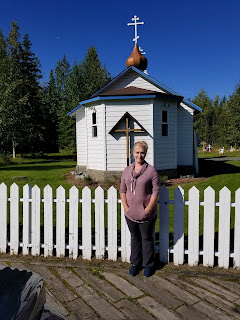Eklutna Alaska Spirit Houses
Eklutna is a small Native Alaskan village about 20 minutes
from my house in Palmer, it sits on the site where many Athabscan Indians lived as long
as 800 years ago. This Dena’ina Athabascan
village is the oldest continuously inhibited location in the Anchorage area; and
the last of eight villages that existed before the Alaskan Railroad was built
in 1915, bringing many new people and cultures to the area.
In 1840, Russian Orthodox missionaries began arriving in the
area, the missionaries started to teach the native residents. With time most of the of the Dena’ina people in the area converted to this new
religion, and began to incorporate the Russian traditions with their own. Prior to the arrival of the Russian Missionaries,
the Dena’ina people would cremate their dead and then place the ashes in a
basket by the river or in a tree. After the missionaries arrived, they told
the Dena’ina people they could no longer cremate their loved ones, instead they should be
buried following the Russian Orthodox traditions.
 A beautiful log church was built in Knik sometime between
1830 and 1870 and was moved to its current location in Eklutna in 1900 where it
was used for services until the new Saint Nicholas church was built in 1962. The
last traditional Athabascan Chief Mike Maxim Alex headed the building of the
new church; this new church is still used today.
A beautiful log church was built in Knik sometime between
1830 and 1870 and was moved to its current location in Eklutna in 1900 where it
was used for services until the new Saint Nicholas church was built in 1962. The
last traditional Athabascan Chief Mike Maxim Alex headed the building of the
new church; this new church is still used today.
Around the church, a graveyard was built and the Dena’ina people began to mix their old customs with the new Russian Orthodox ones. They
began to bury their dead, the body would be buried in a grave then the grave
covered in rocks and a blanket placed over the top to keep the grave warm and to provide warmth to the soul as it moves on to the next world. It is the Russian Orthodox belief that it takes
40 days for the soul to move from this world to the next. The Dena’ina people people
began to build spirit houses over the tops of their loved ones graves to give
the souls a place to exist without disturbing the living while they completed
their journey to the next world.
There are about 100 beautiful spirit houses outside Saint
Nicholas’s church, some have been there for over 100 years, and some are new. A few of the houses are very elaborate while
others are simple; the houses are painted in the colors of the family with married
couple often having their houses painted a combination of the two families.
Some of the houses have “treasures” inside; many have items left around the
outside of them.




A small house inside a larger one represents a mother and child
who passed away together, a fence around the spirit house and grave indicate
that the person did not live in the community. Each grave also has an Orthodox
cross, a three barred cross where the upper arm represent the inscription over
Christ’s head, the middle bar is for his outstretched arms and
the lower slanting bar represents Christ’s footrest, a few of the gravesites
also had traditional grave markers. Among
the spirit houses there are also graves with no spirit house, instead just the
rocks and blanket, these are the graves of the Orthodox nonnative members of
the community.
As we walked the trails among the graves we noticed that many of the houses have fallen into disrepair, literally falling apart over the grave, this is due to the Athabascan belief that what comes from the Earth must return to the Earth, so many of the native members do not maintain the houses once they have been built.
This cemetery was peaceful and beautiful, the intertwined cultures of the Russian and the Native Dena'ina people is so perfectly "Alaskan", I will return again to spend more time walking among these fascinating little houses.













Comments
Post a Comment